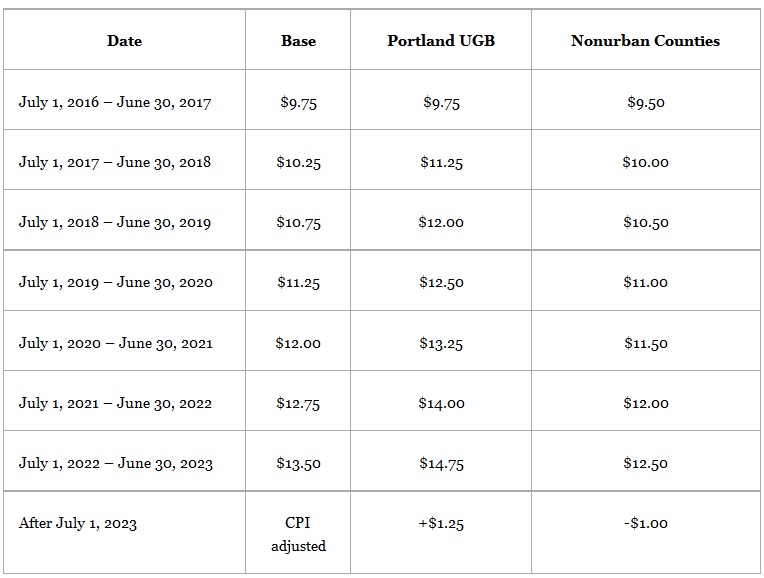![]() Barran Liebman
Barran Liebman
Oregon Law Firm
Brace Yourselves for Oregon’s New and Unprecedented Minimum Wage System
By Josephine Ko
Beginning July 1, 2016, the State of Oregon will be pioneering a unique and complex multi-tiered minimum wage system with significant annual increases. No other state has a minimum wage system like this today. The Oregon state legislature passed Senate Bill 1532 in a historic vote yesterday after much contentious public and legislative debate. Governor Kate Brown announced her intention to sign the landmark legislation into law. The law will be officially enacted as soon as the governor signs the bill.
Under the new law, the state will be split into three geographic regions with three different minimum wage rates and three different rate increase schedules. Initially, on July 1, 2016, the base state minimum wage will increase from the current rate of $9.25 per hour to $9.75 per hour. Employers within the Portland Urban Growth Boundary (“UGB”) will also be required to pay a minimum wage of $9.75 per hour. However, employers located in the nonurban counties of Baker, Coos, Crook, Curry, Douglas, Gilliam, Grant, Harney, Jefferson, Klamath, Lake, Malheur, Morrow, Sherman, Umatilla, Union, Wallowa, and Wheeler, will be required to pay a minimum wage of $9.50 per hour.
According to the statutory rate schedule, each of these minimum wage rates will steadily increase at different rates in each subsequent year, as described in the chart below. By July 1, 2023, the base minimum wage will rise to $13.50 per hour, while minimum wage for employers in the Portland UGB will be $14.74 per hour and in the nonurban counties will be $12.50 per hour. After 2023, annual increases for the base minimum wage will be pegged to the cost of living index. Employers in the Portland UGB will pay a premium of $1.25 per hour over the adjusted base rate, while a discount of $1.00 per hour will apply to employers in the nonurban counties. Oregon’s Bureau of Labor and Industries is charged with adopting rules for determining an employer’s location for purposes of determining which rate applies.
Governor Brown enthusiastically announced her support for the new law. According to Governor Brown, SB 1532 advances one of her priorities and “gives working families the much-needed wage boost they need, and addresses challenges for businesses and rural economies presented by the two impending ballot measures.” Approximately five percent of the state’s laborers earn minimum wage. An estimated 100,000 workers will see pay increases under the new minimum wage law. Keep in mind that there may be more changes to the minimum wage law coming. The new law was a hard compromise between multiple competing interest groups. However, it might not be enough to satisfy supporters of two November ballot measures which were expected to ask voters to raise the minimum wage rate in half the time to $13.50 or $15.00, and other legislative bills might be in the pipeline. Stay tuned.
Disclaimer: Articles featured on Oregon Report are the creation, responsibility and opinion of the authoring individual or organization which is featured at the top of every article.



